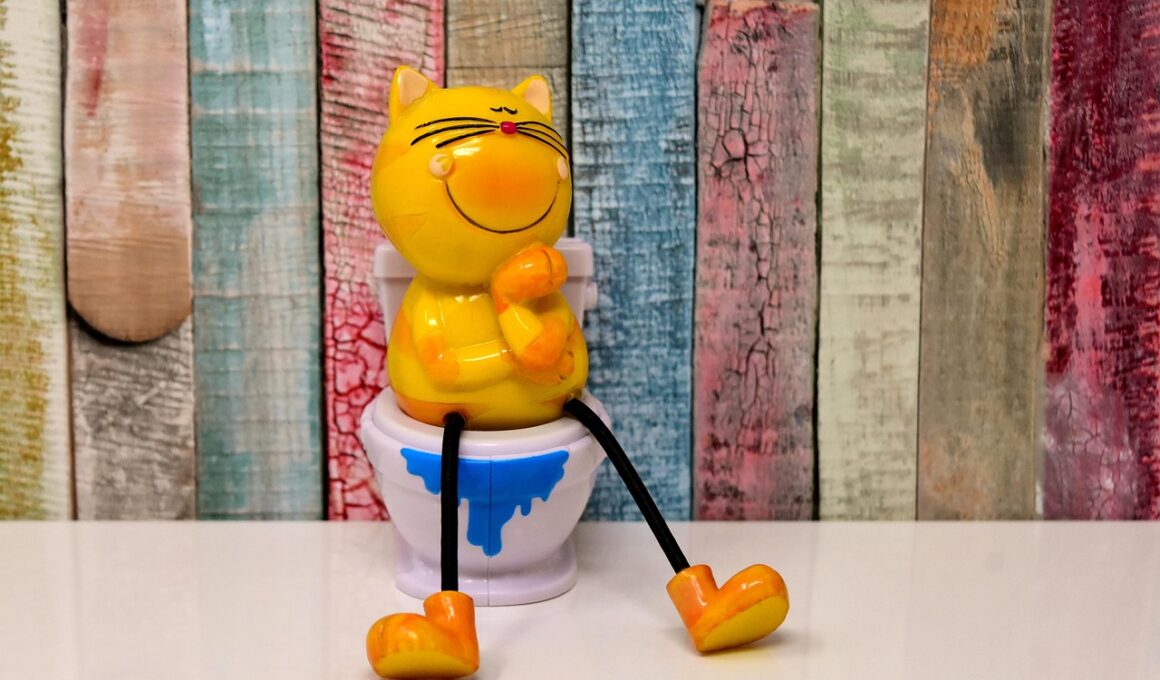How to Prevent Litter Box Accidents During Training
Training a kitten or cat to use the litter box successfully can sometimes be challenging, but there are effective strategies to minimize accidents. One essential technique is to choose the right litter box size and type. Ensure it is accessible, sturdy, and spacious enough for your cat. If possible, select a box with low edges to facilitate entry and exit. Cats generally prefer clumping, unscented litter as it is more appealing. You should also place the litter box in a quiet, private location to make it more inviting. Additionally, avoid placing the litter box near their food and water dishes, as this can deter them from using it. Observing your pet’s behavior can provide insights; for instance, if they seem hesitant to use the box, try a different location. Another way to prevent accidents is to establish a regular feeding schedule. This consistency helps regulate your cat’s elimination habits, making it easier to anticipate when they need to go. Keep a clean box to encourage regular use, as cats are creatures of habit who thrive in cleanliness. Regularly scooping the box and changing the litter will enhance your training efforts.
In addition to basic litter box maintenance, pay close attention to any issues that could arise during the training process. A common reason for accidents is stress or changes in the household. Cats can be sensitive to new environments, so avoid moving the litter box or changing the litter abruptly. If you must relocate the box, do so gradually, allowing them to adjust to the new location. Keeping a written log of your cat’s litter box habits may also be beneficial. Record when they use the box and when they have accidents to establish patterns. This information can help pinpoint triggers for trouble spots. If your cat has an accident outside the box, clean it thoroughly with an enzymatic cleaner to eliminate odors. If they can still smell their previous elimination, they might be inclined to repeat the mistake. Also, observe your cat’s health for any signs of urinary issues, as these may also lead to litter box avoidance. If you suspect any health problems, consult a veterinarian promptly to address these concerns. Early intervention can prevent further accidents and allow for a more seamless training experience.
Creating a Positive Environment for Training
Creating a positive and reward-based environment can significantly enhance the success of your litter training efforts. Consider using treats or verbal praise every time your cat uses the litter box correctly. This reinforcement motivates them to repeat the behavior consistently. Try to use a designated area or specific treats during training sessions, which can create a positive association with the litter box. You may also incorporate light playtime to reward good behavior associated with using the box. Additionally, make sure to remain patient throughout this process. Cats may take time to get used to new routines and expectations, so don’t rush them or punish them for accidents. Instead, calmly redirect them to the box if you catch them in the act. If you can catch them before an accident occurs, gently place them in their box. Maintaining a calm demeanor can help lower your cat’s stress and anxiety. Each positive experience around their litter box can reinforce their preference for that area, helping to reduce anxiety and fear surrounding it. Over time, your patience and encouragement will guide them towards becoming litter box proficient.
It’s essential to be mindful of your cat’s signals when they express the need to use the litter box. Watch for tell-tale behaviors like sniffing, circling, or scratching around. These signs can indicate their urgency and remind you to redirect them immediately to their designated area. If you are attentive to their behavior, the likelihood of accidents decreases significantly. Another helpful measure involves having multiple litter boxes available, especially in multi-cat households. Providing multiple boxes in different areas allows each cat to have easy access whenever they need it. As a general guideline, if you have two cats, you should have at least three litter boxes. This setup helps prevent territorial disputes and reduces the chances of litter box aversion. Ensure that all boxes are well-maintained, clean, and filled with fresh litter. Also, consider having different litter types available to determine your cat’s preference. Some may prefer clumping sand, while others might like natural or alternative litter types. Offering choices can help create a more appealing environment for your cat, ensuring they feel comfortable and confident in using the boxes provided.
Handling Setbacks in Training
Setbacks are a common part of the litter training process and should be addressed with understanding and care. If your cat starts having accidents consistently despite proper training, it’s crucial to reassess their environment and stressors. Check for any changes that might be causing discomfort, such as loud noises, new pets, or changes in routine. Additionally, maintaining a consistent cleaning schedule is essential. Cats are fastidious creatures, and a clean litter box encourages them to use it for their elimination needs. If they notice a soiled box, they may choose to disregard it altogether. Setbacks can also be a cry for help regarding underlying health issues, which may require veterinary assistance. If your cat is young or newly adopted, they may need extra time to adjust to their new surroundings. Always be willing to adapt your strategies according to individual needs and preferences. Common behavioral issues may occur, but staying committed to a positive and nurturing environment will support successful litter training in the long term. Once you make adjustments and create a supportive atmosphere, chances are your cat will respond positively during this phase.
Regularly monitoring your cat’s habits and adjusting their training as needed is vital for effective litter box training. Keeping your household stress-free will minimize potential setbacks more effectively. A calm and conducive environment will allow your cat to thrive. If you encounter issues, return to basics, reinforcing positive behaviors and introducing gentle corrections when necessary. Throughout this process, maintaining constant communication with your cat will help strengthen the bond between you and encourage cooperative behavior. Your approach should always emphasize understanding rather than punishment, particularly when it involves mistakes. Encouragement, patience, and consistency yield the best results in any training endeavor. Remember to celebrate small victories along the way, ensuring that you recognize their successes as signs of progress. Small steps lead to long-lasting habits; each time your cat uses the box successfully, offer praise and rewards to create a habitual pattern. Regular praise serves to reaffirm positive behavior and reinforce the benefits of using the litter box consistently. With time and consistency, these efforts will lead to a successful and accident-free litter training experience, allowing both you and your feline companion to thrive.
Ultimately, the goal of litter training is to achieve a confident and reliable routine for both pet and owner. It requires dedication and a comprehensive understanding of your cat’s needs and behaviors. Preparing for potential challenges, investing time in creating a positive environment, and maintaining a close observation of your cat’s actions are vital. The reinforcement of their successes through praise and rewards will indelibly create the right associations with litter box usage. Cats are naturally inclined to bury their waste, and with proper training, this instinct will surface as part of their daily routine. Using these techniques during your training journey ensures a strong foundation for a healthy, stress-free relationship with your cat. The understanding you gain during this training period will foster trust and comfort for your cat. Always remain vigilant and flexible to tweak your strategies as necessary while providing a nurturing environment for your feline friend. Getting to know your individual cat’s habits and preferences is key to this training. Stay committed to creating a positive atmosphere, paving the way for long-term success in achieving dependable litter training.
In summary, successful litter training hinges on a harmonious balance of patience, attention, and proactive measures. Addressing your cat’s behavioral signals, ensuring cleanliness, and adapting to their preferences are integral parts of this process. Similar to any form of training, setbacks may arise, but it’s vital to approach these moments with understanding. By nurturing a positive environment, seeking veterinary help when necessary, and creating a structured routine, you can significantly reduce the risk of accidents. Over time, assisting them to acclimate to the litter box will yield successful results and build a stronger bond between you and your cat. Cats are creatures of habit that thrive under consistency, so ensuring that they can predict their opportunities for elimination is essential. As they continue to understand their role in the home, creating stress-free interactions around litter use is crucial. Celebrate their successes, no matter how small, to reinforce the desired behavior. Every positive experience will help solidify that using the litter box is rewarding. Stay dedicated to the journey. With your commitment to their training, you and your feline friend will happily adapt to living together.


